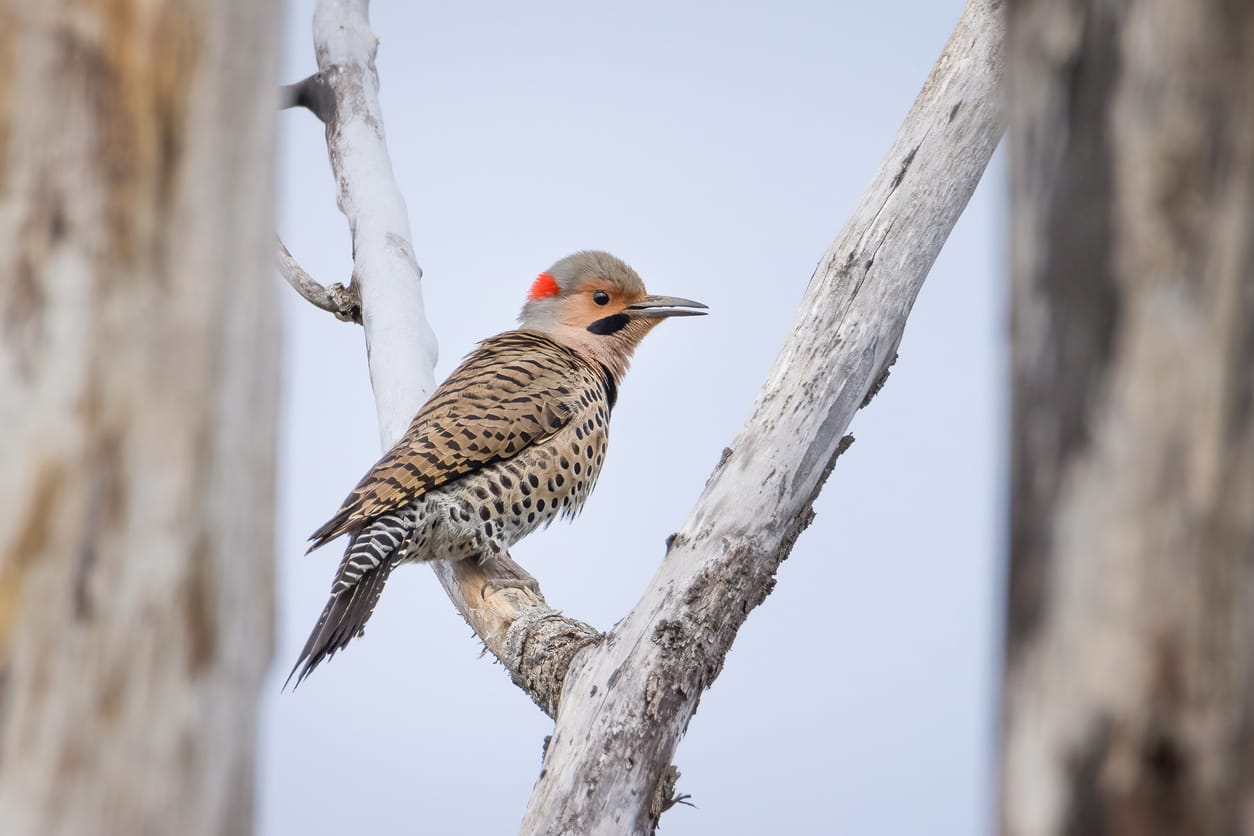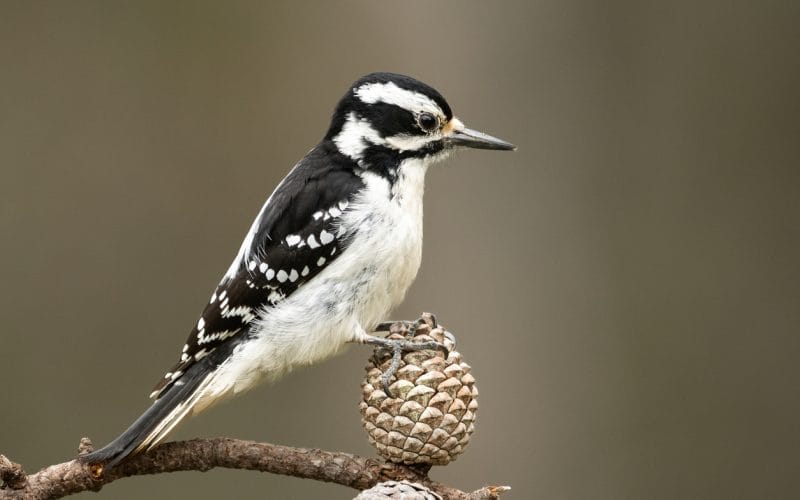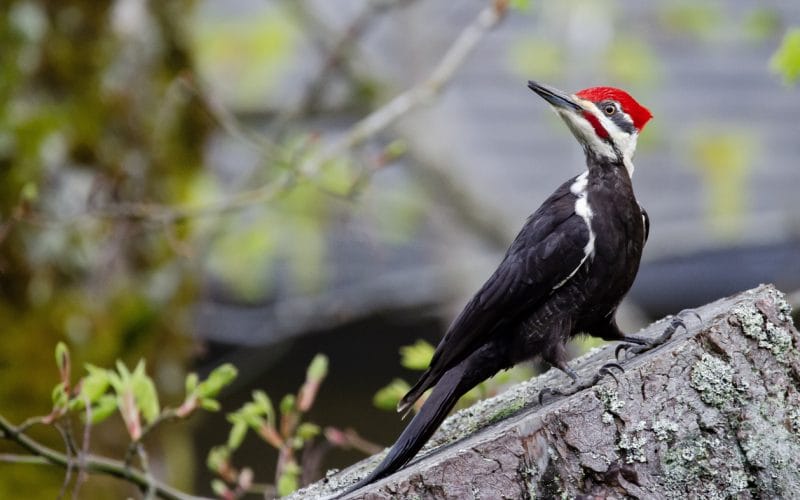Iowa is covered by over 8% forest land, which is the optimal breeding ground for woodpeckers. They feed on tree sap and insects living in the tree bark. Not only that, but they make homes out of hollow tree trunks.
These are seven different types of woodpeckers that choose to call the state home:
- Hairy Woodpecker
- Downy Woodpecker
- Pileated Woodpecker
- Red-bellied Woodpecker
- Red-headed Woodpecker
- Northern Flicker
- Yellow-bellied Sapsucker
You can spot any of these beauties if you go birding in the forest or set up bird feeders in your own backyard. Some are year-long Iowa residents, while others travel south for the winter.
Let’s dive into the characteristics of each type. We’ll also talk about what they like and how you can attract them to your backyard.
The 7 Types of Woodpeckers in Iowa
Here’s a list of the woodpeckers you can find in Iowa.
1. Hairy Woodpecker
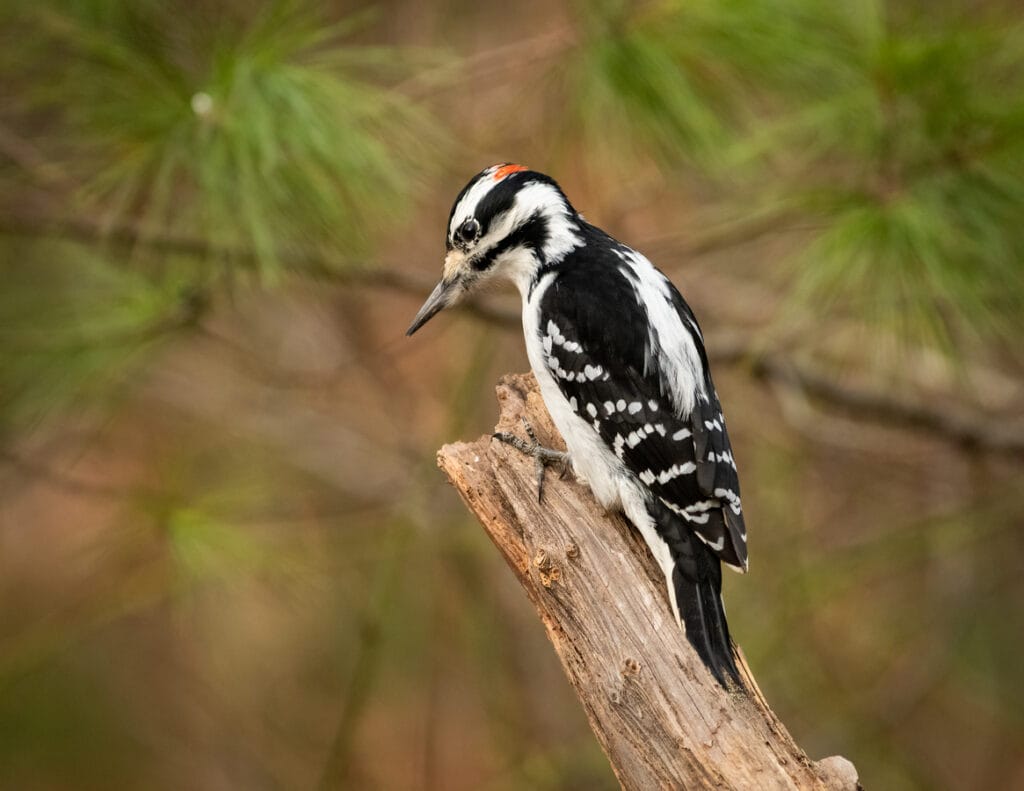
- Scientific name: Dryobates villosus
- Length: 7.1–10.2 in (18–26 cm)
- Weight: 1.4–3.4 oz (40–95 g)
- Wingspan: 13.0–16.1 in (33–41 cm)
The Hairy Woodpecker is between a robin and a swallow in size. It can be found in forests, as well as in human-made areas such as orchards, woodlots, and even cemeteries.
Both sexes have a similar appearance with a striking contrast of black and white feathers. However, male Hairy Woodpeckers are different in that they have a distinctive brush of red toward the back of the head. In fact, it’s their main distinguishing feature.
Author Note: Hairy Woodpeckers mainly feed on insects, which comprise nearly three-quarters of their diet. They’re drawn to wood-boring and bark beetle larvae, as well as moth pupae, which can help control insect infestations.
The remaining quarter of their diet consists of fruits and seeds. Moreover, they also happen to frequent bird and suet feeders if available.
The Hairy Woodpecker nests inside dead trees or hollow stubs of living trees. The female prefers branches or stubs that are more diagonal, creating the opening on the underside. This prevents unwanted visitors, like sapsuckers or flying squirrels, from taking over the nest cavity.
You can find Hairy Woodpeckers year-round in Iowa. They’re also common all over the United States.
2. Downy Woodpecker

- Scientific name: Dryobates pubescens
- Length: 5.5–6.7 in (14–17 cm)
- Weight: 0.7–1.0 oz (21–28 g)
- Wingspan: 9.8–11.8 in (25–30 cm)
The Downy Woodpecker almost looks like a miniature version of the Hairy Woodpecker because they share the same black-and-white coloring. Yet, the former has a checkered pattern on their wings. In addition, their heads are boldly striped, with a red mark on the back of the head for males.
Adult birds are between the size of a sparrow and a robin. Accordingly, it’s categorized as the smallest woodpecker species in Iowa and all of North America.
Downy Woodpeckers live in open woodlands, as well as in cemeteries, vacant lots, and city parks. Like Hairy Woodpeckers, they nest in dead trees or dead parts of living trees.
Their diet is quite similar to their larger counterparts, the Hairy Woodpeckers. You’ll find them mostly eating insect larvae from trees. However, they also enjoy fruits and seeds, which constitute a quarter of their dietary needs.
Downy Woodpeckers don’t migrate in the winter and can be found in Iowa year-round. You can find them eating from suet feeders, snacking on black sunflower seeds, and enjoying nectar from hummingbird feeders as well.
3. Pileated Woodpecker

- Scientific name: Dryocopus pileatus
- Length: 15.8–19.3 in (40–49 cm)
- Weight: 8.8–12.3 oz (250–350 g)
- Wingspan: 26.0–29.5 in (66–75 cm)
The Pileated Woodpecker is the largest woodpecker species you can find in Iowa and, in fact, all of North America. It’s almost the size of an American Crow and about ten times the size of a Downy Woodpecker!
They live mostly on mature deciduous or mixed deciduous-coniferous woodlands. They prefer having a steady supply of decaying wood so that they might be found in the suburbs or young forests with a lot of dead trees.
Both sexes are of the same size and have a similar appearance. The Pileated Woodpecker is primarily black with white markings on the face and the top of the wings. It gets its name from the vibrant red, triangular crest covering its head. The males also have red markings on their cheeks.
Author Note: The Pileated Woodpecker mainly feeds on carpenter ants, which form at least 40% of its diet. Although it supplements its diet with other insects, such as beetles, cockroaches, and grasshoppers.
This type of woodpecker also gets its nutrition from wild nuts and fruits, such as blackberries, poison ivy, greenbrier, hackberry, sassafras, sumac berries, persimmon, holly, dogwood, and elderberry.
These shy birds live year-round in Iowa, but mainly on the Eastern side. Of course, you can always try to lure one to your backyard by setting up a suet feeder.
4. Red-bellied Woodpecker

- Scientific name: Melanerpes carolinus
- Length: 9.4 in (24 cm)
- Weight: 2.0–3.2 oz (56–91 g)
- Wingspan: 13.0–16.5 in (33–42 cm)
At first glance, you might want to call this type of woodpecker the Red-headed Woodpecker. Although, this name is reserved for the next, much rarer species.
Red-bellied Woodpeckers are between a robin and a swallow in size. They have a stripe of red down the middle of their heads. They also have pale red bellies, which can be hard to spot when they’re up against a tree or a feeder.
Instead, you can look for the mohawk-like stripe of red as a distinction from their less common and completely Red-headed counterparts. The striped pattern on their backs also differs from the solid black and white coloring of the Red-headed Woodpecker.
Red-bellied Woodpeckers live in mostly oak and hickory woodlands, but they can also live in young forests of hardwoods and pine trees. In addition, they can be found in wetlands and riverbanks, where they feed on small fish.
You can find them in the suburbs, as well, where there’s no shortage of trees to find food and nest inside. They have an interesting nesting activity, where they nest in the same hole or inside a new hole in the same tree year after year.
Their diet consists mainly of insects, seeds, and arthropods. Yet, their favorite snacks are juicy fruits, like grapes, oranges, and mangoes. In addition, they’ve also been spotted feeding on lizards, smaller birds, and minnows.
You can spot them in your backyard if you have a suet feeder, as they live in Iowa year-round.
5. Red-headed Woodpecker
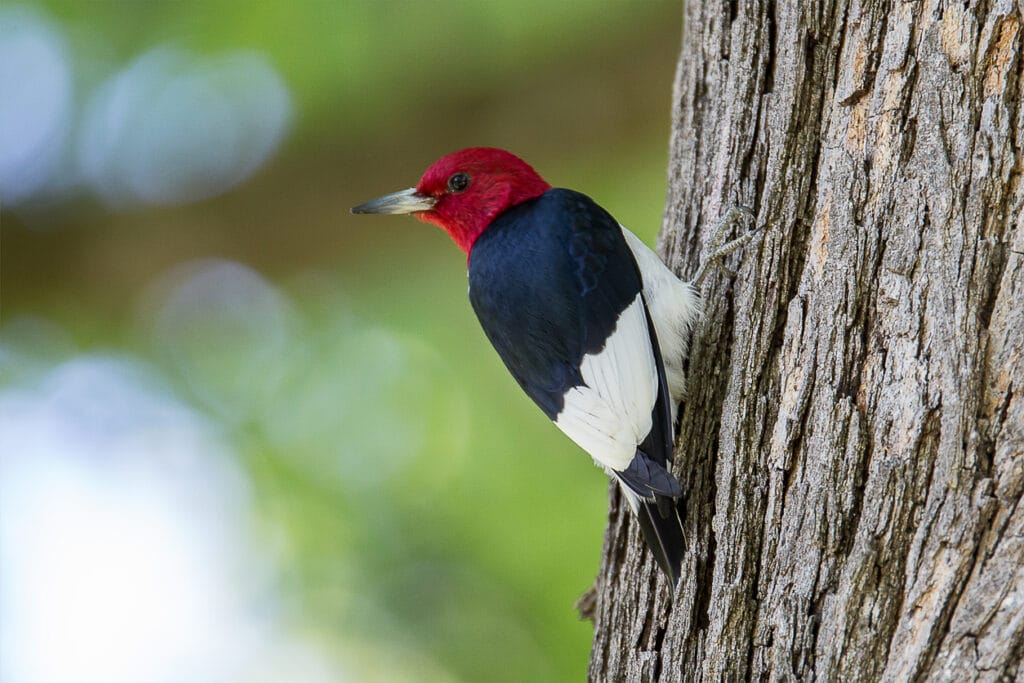
- Scientific name: Melanerpes erythrocephalus
- Length: 7.5–9.1 in (19–23 cm)
- Weight: 2.0–3.2 oz (56–91 g)
- Wingspan: 16.5 in (42 cm)
The Red-headed Woodpecker is the least common species on this list, as their population steadily declined by 1% each year from 1966 to today. They’re currently on the Yellow Watch List of birds since the cumulative drop of 56% massively decreased their population.
Their size is comparable to the Red-bellied Woodpeckers, which are roughly between a robin and a crow. They have a full head of red plumage, followed by a black back with a single white stripe at the lower end of the wings and white underbellies.
They live in multiple habitats, ranging from oak, hickory, ash, beech, and mature maple forests in the north, to pine and pine-oak in the south. At the start of the breeding season, these red-heads seek clearings like riverbeds, recently burned forests, beaver swamps, and forest edges.
Author Note: Red-headed Woodpeckers are some of the least carnivorous species, as they only rely on insects and larvae for one-third of their dietary needs. They’re gifted flycatchers, though, and can catch aerial insects mid-air. The other two-thirds are met by nuts, seeds, grains like corn, berries, and other fruit.
However, they can sometimes raid other birds’ nests to prey on their eggs, and they can hunt mice and other adult birds that are smaller in size. They store food, like nuts and live insects, behind tree bark and under house shingles, often moving it from one place to another before retrieving it.
You’ll have to go birding if you want to see a Red-headed Woodpecker in action, as they don’t always fly into backyards. They’ll visit a suet feeder every now and then, though.
6. Northern Flicker

- Scientific name: Colaptes auratus
- Length: 11.0–12.2 in (28–31 cm)
- Weight: 3.9–5.6 oz (110–160 g)
- Wingspan: 16.5–20.1 in (42–51 cm)
These colorful, spotted-belly beauties are about one-and-a-half times as big as a Hairy Woodpecker. The Northern Flicker found in Iowa will have a brownish tone, with a bright-yellow-colored underside to its wings and tail. The males have red markings on their cheeks, as well.
Northern Flickers prefer large clearings with scattered trees, such as forest edges, city parks, open fields, and suburban areas. They’re also attracted to wetlands, like marsh edges, riverbanks, and flooded swamps.
They mainly feed on insects, like ants and beetles, that they get from the ground. To do this, these handy birds break the soil with their sharp beaks in search of food underground in a similar motion to how other woodpeckers find food in trees.
In winters, they eat seeds and fruits like wild cherry, grape, bayberries, hackberries, and elderberries. They also eat poison oak and ivy, dogwood, sumac, and thistle seeds.
The Northern Flickers nest in old burrows made by other birds or the same nest they occupied in the previous seasons. They prefer to nest about 6–15 feet above the ground, though occasionally, their nests can reach over 100 feet high.
They’re not known for being great backyard feeders, but you can attract them by placing an appropriately-sized nesting box on a tree. Just make sure to put it in place sufficiently ahead of their breeding season and set up a predator guard to protect the eggs and younglings.
7. Yellow-bellied Sapsucker

- Scientific name: Sphyrapicus varius
- Length: 7.1–8.7 in (18–22 cm)
- Weight: 1.5–1.9 oz (43–55 g)
- Wingspan: 13.4–15.8 in (34–40 cm)
The Yellow-bellied Sapsucker is about robin-sized, more prominent than the Downy Woodpecker, and slightly smaller than the Hairy Woodpecker.
Their name leads one to believe they have bright yellow bellies. However, their bellies have a white or pale yellow color. Their folded wings also have a white stripe on each side.
Their most apparent markings are on their heads, which are boldly striped with red and black. The male Yellow-bellied Sapsuckers also have a red throat that sets them apart from the white throat of the females. In addition, they hold their head feathers up, creating a peak over their heads.
Top Tip: Unlike other woodpeckers, they rely mostly on young, living trees for feeding. Just like people tap maple trees to get the sap, Yellow-bellied Sapsuckers tap trees with their beaks. They insert their beaks in the resulting sap wells, catching the flowing liquid with their tongues.
In the spring and summer, they prefer young forests with plenty of food. However, they aren’t as selective in the winter and can be found in hickory, pine, and oak forests.
In addition to tree sap, Yellow-bellied Sapsuckers also eat ants, spiders, and flies. They find the insects underneath the tree bark, like other woodpeckers do, and catch them mid-air in flight, like flycatchers.
You can also find them perched in orchards, where they tap the trees and eat the fruits and seeds.
Unless you have young birch or maple trees in your backyard, there’s a slim chance you’ll see a Yellow-bellied Sapsucker there. However, they might be attracted to suet feeders in the winter, so it might be worth a try.
In Conclusion
There’s a total of 22 Woodpecker species in the United States. The seven types of Woodpeckers in Iowa make up a third of these, which is pretty impressive.
If you live in Iowa, there’s a big chance you’ll come across one of the gorgeous Woodpecker species that call the Hawkeye State home. Whether you live near the forests, a vacant clearing, or down by a riverbank, you might find one of those beauties pecking away.
FAQ
The Hairy and Downy Woodpeckers are the most common species in Iowa.
These places are good for a start:
Lacey-Keosauqua State Park , DeSoto National Wildlife Refuge, Yellow River State Forest, Great River Birding Trail are all good places to possibly see the Red-headed Woodpecker and Pileated Woodpecker.
To find out where recent sightings of woodpecker have been, try eBird. You can search for the latest sightings or particular species or what has been seen in a certain area.




